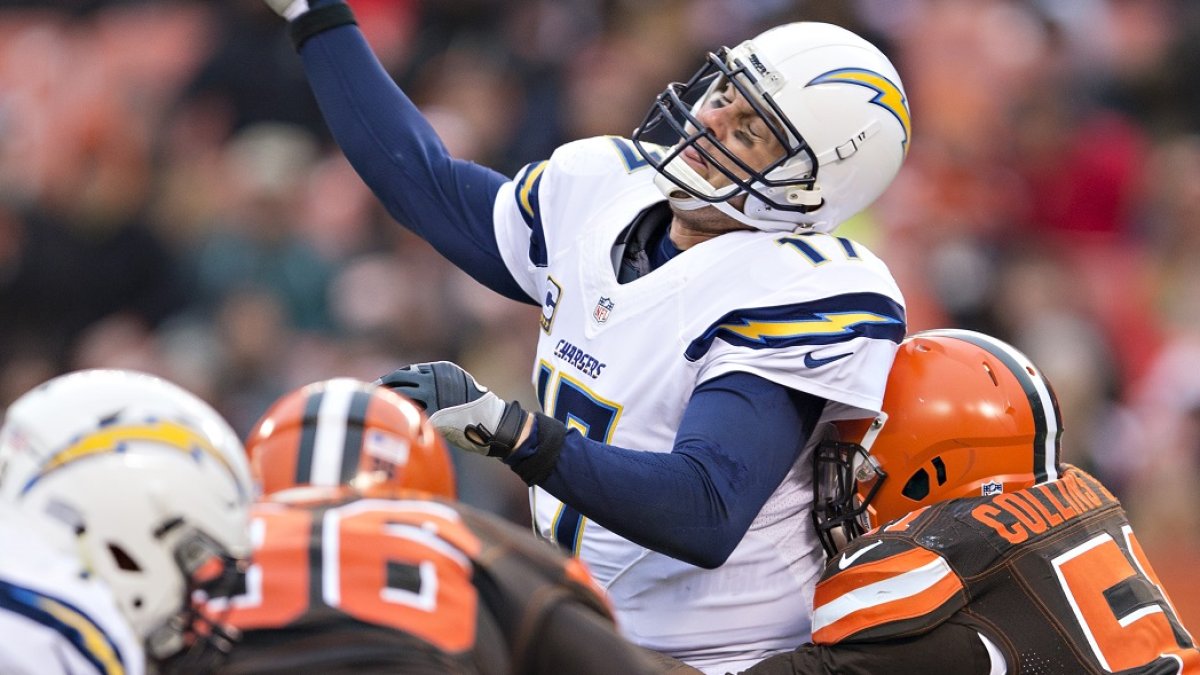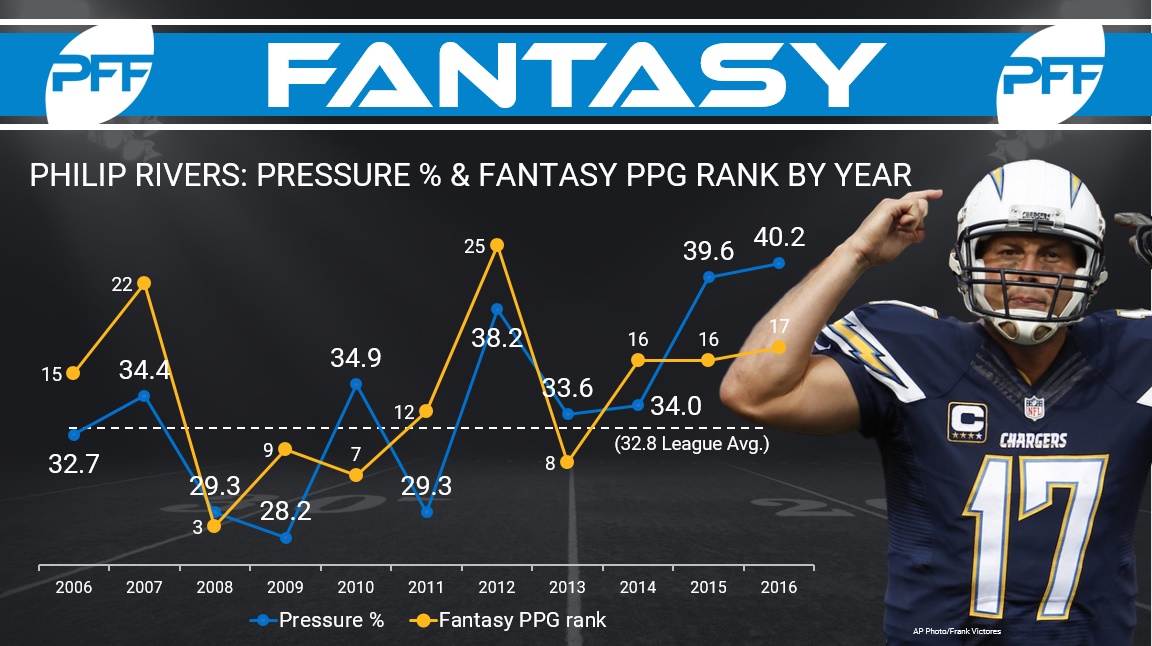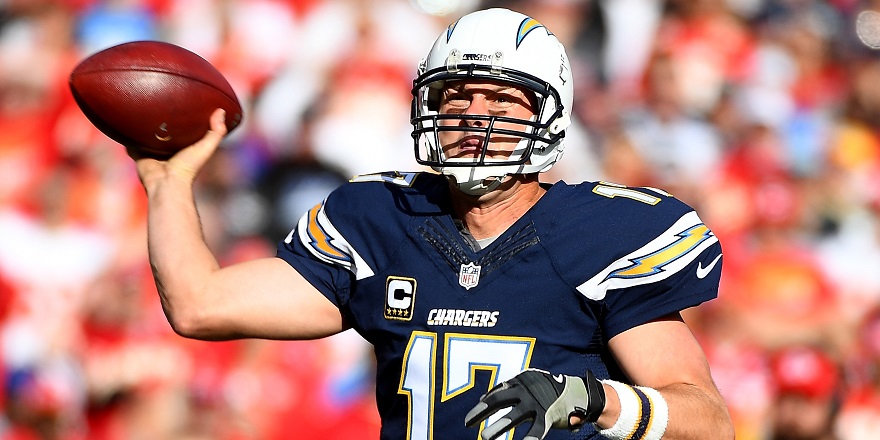(“Today’s Crazy Fantasy Stat” is an occasional offseason offering from PFF that highlights something that catches our eye and aids in our preparation for the 2017 fantasy season.)
Sometimes, you go looking for a simple answer and it turns out to be complicated. A lot of the time, actually. It’s rare for a problem have a single, simple answer, because if it did, that would be fixed quickly.
But sometimes, and these times are oddly satisfying, you go in expecting a complicated answer, with five or six competing factors, and you find the apparent answer sitting right there.
Long story short, sometimes protecting a quarterback leads to that quarterback playing better.
Join PFF Elite for access to PFF Signature Stats across all positions.
In the PFF era (2006-present), Philip Rivers has had five seasons as a top-12 fantasy quarterback by fantasy points per game, and six seasons outside that group, including four of the last five years. Across the league, since 2006, quarterbacks have been under pressure on 32.8 percent of their dropbacks. In the five years Rivers was a QB1, his pressure percentage was 31.1 percent. In the five years he wasn’t, that number was 36.8 percent.
(Reminder that lower's better on both of those lines.)
Last year, Rivers had 26 touchdowns against 10 interceptions when he was clean, compared to 7 touchdowns and 11 interceptions when he was pressured, a swing from a 2.6 TD:INT ratio to an 0.64. The only quarterbacks who had a worse swing were Andrew Luck, Andy Dalton, Blake Bortles, Carson Wentz, Dak Prescott, and Derek Carr.
Rivers — helpfully enough, dude never misses a game, so there’s not much need to prorate his scales, and my middling Excel skills thank you for that, Philip — has been sacked more than 30 times in a season five times. Four of those were in that last-five-year sample, corresponding nicely to his recent struggles. And frankly, it’s a miracle he’s been on the field as much as he has — the Chargers haven’t ranked better than 19th in PFF grades for pass-blocking since 2007, grading out 26th or lower in four of the last seven years (including a cool last-place grade in 2015 and 27th in 2016).
In related news, the Chargers haven’t spent a first-round pick on an offensive lineman since 2013 (D.J. Fluker), and only drafted two total in the 2014-16 drafts (G Chris Watt, third-rounder in 2014, and C Max Tuerk) — neither of whom played a single snap in 2016.
Here’s another way of saying that: Entering this year’s draft, the Chargers did not have a single offensive lineman on their roster that they had drafted and who had even one snap of experience.
In an effort to at least partially help things, the Chargers drafted PFF’s No. 1 and No. 3 guards in this year’s draft class (Forrest Lamp and Dan Feeney) in the second and third rounds, respectively, and added OT Sam Tevi out of Utah in the sixth. Those three, combined with free-agent acquisition Russell Okung, should help matters (even if Lamp is the only draft pick PFF currently predicts to start). The unit ranked only 21st in PFF’s recent offensive line rankings, though those rankings were purely grades-based and didn’t account for helpful rookies. In other words, the Chargers might have the 21st-ranked line in 2017, but that seems like the floor, not necessarily the most likely outcome.
What does that mean for Rivers? Well, there are obviously no guarantees with rookies and quick rebuilds, but it should mean a bit more protection for the veteran, which in turn should mean a lower pressure percentage, which, as we’ve seen, theoretically leads to better fantasy production.
That Chargers have weapons. Antonio Gates is still around, productive despite the fact that we’re actively watching him fossilize. Hunter Henry just tied for the league lead in touchdowns for tight ends (8) despite being a rookie and seeing only 47 targets, and has drawn talk as the team’s “main” tight end in 2017. No. 1 receiver Keenan Allen is reportedly running at full speed after last year’s ACL tear, Tyrell Williams was just the No. 11 fantasy WR a season ago, and even Melvin Gordon was PFF’s No. 4-graded RB in receiving a year ago. First-round draft pick Mike Williams has had a slow start to his career as he deals with a mild disc herniation, but even if he takes a bit to get ready for the start of his career, he should be a weapon or the team at some point this year.
Rivers is in the middle tier of quarterbacks. He’s not in the elite group that includes Aaron Rodgers, Tom Brady, Drew Brees, Andrew Luck, and maybe Russell Wilson and Matt Ryan. After that, the middle tier goes deep, with as many as 10-12 names vying for space. We know — as much as we know for any football player — that Rivers is likely to be healthy all season. His offensive line should be (much-?) improved in 2017, his weapon stable is as deep as any (if perhaps lower-ceiling than some), and — if you feel like some soft factors here — his team’s in a new city with something to prove.
Like minds may differ, but Philip Rivers is my No. 8 quarterback heading into the 2017 season. Meanwhile, per Fantasy Football Calculator, he’s going off the board 14th. That’s value right there.





 © 2024 PFF - all rights reserved.
© 2024 PFF - all rights reserved.